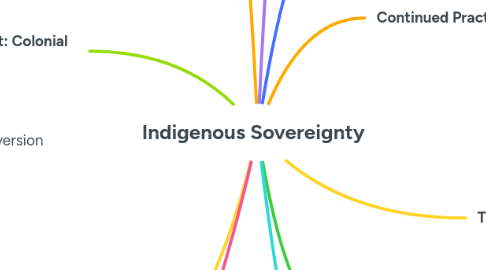Indigenous Sovereignty
Sam Reenにより


1. Historic colonial context: Colonial Intent
1.1. The doctrine of Terra Nulllius
1.2. Assimilationist policies
1.3. Eurosion of culture and identity
1.4. Eurocentric political ideology
1.5. Injusutice and dispossession
1.6. Imposition and non-consentual authoritarian sovereignty practices of British Colonists
1.6.1. While we have been stamped ‘British subjects’ and ‘Australian citizens’, many FIrst Naitions Australians affirm sovereignty as people who have never entered into consensual relations with any state or British Crown to surrender international status. (Watson, 13)
1.7. [Un]Lawful Authority
2. Indigenous vs Westphalian Sovereignty: Can the two align or coexist in todays context?
2.1. Onus of proof is on Aboriginal Australians to prove rightful 'authority' / status and in particular their continuing sovereignty.
2.1.1. Rightfully, the State should carry the burden of proof and be called upon to prove by what lawful it has come into existence.
2.2. Power and authority
3. Recognition, Acceptance and Accountability
3.1. Aboriginal peoples’ status as sovereign and independent is not a claim to be given but one that seeks a re-affirmation of who they have always been (Watson, 13)
3.2. sovereignty has to be understood as a political concept, and not as a legal one. It should follow that any path to the recognition of sovereignty is not to be found through the courts, but through negotiation and the political process. (Sovereignty in the Victorian context 2020)
4. FIrst Naions Governance and Self-determination in-practice
5. Key underpinning principles
5.1. Culture, Lore & Customs
5.2. Country
5.3. Language
5.4. Intrinsic understanding / interconnection
6. Uluru Statement of the Heart is an example of Indigenous sovereignty, with ancestral relationship to Country, Culture and Community. Thie Statement makes it clear that co-ownership with the Crown can occur with regards to sovereignty.
7. What is Indigenous sovereignty?
7.1. First Nations Peoples of 'Australia' have complex legal systems which have evolved over thousands of years (Irene Watson, p.3)
7.2. Treaties & First Nations Peoples in 1788
7.2.1. agreements negotiated between First Nations Communty - evidenced by song lines and mutual respect shared between them for the meeting of song lines; shared spaces; exclusive spaces; private spaces; public spaces; trading spaces; and gendered spaces. (Watson,12)
